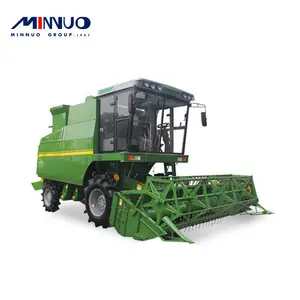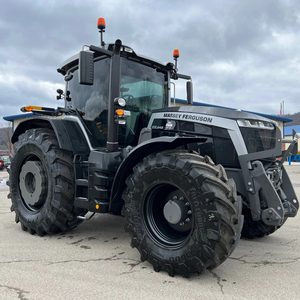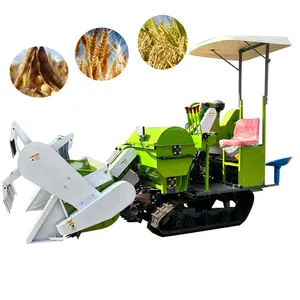







Related Searches:






















Top categories
About agricultural machine
Types of agricultural machines
Agricultural machines are used in various stages of agricultural production, including tilling, planting, fertilizing, harvesting, etc. They are mainly divided into the following types:
- Land preparation machinery: These typically include plows, harrows, and cultivators. Plows are used to break up and turn over the soil. Harrows help to break up clods of soil left behind by the plow and smoothen the soil. Cultivators are used to mix and pulverize the soil to create a suitable seedbed for planting. The primary purpose of land preparation machinery is to create an ideal environment for planting by loosening the soil, removing weeds, and aerating the land.
- Planting machinery: This type of agri machine is mainly used for sowing seeds in even rows and at appropriate depths. It includes seed drills, planters, and transplanters. Seed drills are used for sowing seeds in well-organized rows. They can also control the depth at which seeds are sown. Planters are used for sowing seeds in a uniform pattern. Transplanters are used to transplant seedlings from seedbeds to the field. By using these machines, farmers can achieve efficient and precise sowing, which can improve crop yield.
- Protective machinery: This type of machinery is used to protect crops from pests, diseases, and weeds. It includes sprayers, dusters, and weeders. Sprayers are used to apply pesticides or fertilizers to crops. Dusters are used to spread pesticides or insecticides in powder form over crops. Weeders are used to remove weeds from crop fields. Protective machinery can help farmers control pests, diseases, and weeds effectively and efficiently, thus improving crop health and yield.
- Harvesting machinery: These include reapers, threshers, and pickers. Reapers are used to cut mature crops. Threshers are used to separate grains from harvested plants. Pickers are used to pick fruits or vegetables. Harvesting machinery can help farmers to complete the harvesting process efficiently and in a timely manner, which is crucial for preserving crop quality and maximizing yield.
Specification and Maintenance
Modern agricultural farm machinery come with various specifications and require different maintenance practices. Here are some of the specifications and maintenance practices to consider:
- Specifications
Size and weight: Agricultural machines come in different sizes and weights. The size and weight of the machine will depend on the specific tasks they are intended for. Some machines are designed to handle large-scale farming and are bigger and heavier, while others are meant for small-scale farming and are smaller in size.
Power source and power rating: Agricultural machines come with different power sources and ratings. This includes fuel, electric, solar, wind, and human power. The power rating will vary depending on the type of machine. For example, tractors machinery have different power ratings ranging from 20hp to over 500hp. The machines are designed to be used on different types of farms.
Attachments and implements: Agricultural machines have different implements and attachments that are used to do specific tasks. For example, a tractor may come with a plow, sprayer, or harrow. The implements are designed to be used with the power source and are compatible with the machine.
Technology and automation: Some agricultural machines come with automation and technology features. This includes GPS guidance, remote monitoring, and self-driving capabilities. The features are designed to improve efficiency and reduce the workload of the farmer.
- Maintenance
Cleaning: Agricultural machines should be cleaned regularly to remove dirt and debris. This helps prevent the spread of pests and diseases. It also prevents the corrosion of metallic parts of the machines. Farmers should use the manufacturer's recommended cleaning procedures.
Lubrication: Moving parts of the machines should be lubricated regularly. This reduces friction, prevents wear and tear, and improves the performance of the machines. Lubrication also prevents overheating of the machines.
Inspection and repair: Agricultural machines should be inspected regularly for signs of damage or wear. Farmers should check the tires, belts, and hoses of the machines. Any damaged parts should be replaced immediately to prevent further damage. Inspection helps to identify problems early before they become serious. This extends the lifespan of the machines.
Storage: When not in use, the machines should be stored in a dry and clean place. They should be protected from harsh weather conditions and direct sunlight. Storing the machines properly prevents rust and corrosion of metallic parts. It also extends the lifespan of the electronic components.
Operator training: Trained operators are less likely to misuse the machines. They will handle the machines safely and follow the manufacturer's guidelines. Operators should be trained on how to use the machines and the maintenance practices.
Scenarios of agricultural machines
These machines have been widely used in various agricultural scenarios, which is an important part of the entire agricultural production process. Here are some of the scenarios.
- Soil cultivation and seed planting: Tractors and plows are often used for soil cultivation before planting. Cultivators are used for large-scale land cultivation, while seeders are used for mechanized planting. These machines are used for soil aeration, weeding, and mixing of fertilizers and other soil amendments. This can help to improve soil structure and create optimal conditions for crop growth.
- Irrigation and drainage: These machines are used to transport and spread fertilizers, as well as to apply pesticides. By providing fertilizers, pest control, and other agricultural inputs to crops, they can help improve crop yields and quality. In addition, the use of irrigation and drainage systems can help regulate the water supply and drainage of crops, creating an appropriate growth environment for them, and ultimately improve agricultural production efficiency.
- Harvesting and processing: Combine harvesters are important agricultural machines used for harvesting and processing. They can be used to harvest crops such as rice, wheat, and corn. These machines are designed to cut and gather crops in a single operation, which can greatly improve harvesting efficiency. In addition, other processing equipment, such as threshers and rice milling machines, can help separate grains from straw and husks, process them into marketable products, and increase the added value of agricultural products.
- Transportation and logistics: After harvesting, the products need to be transported. Farm trucks and trailers can be used to transport crops from fields to processing plants or markets.
How to Choose Agricultural Machines
When selecting agricultural machines for resale, it is crucial to remember that different types of farm machinery are used for various farm practices. Buyers can categorize the machines based on their uses for different farming activities. These machines can be classified into machines used in soil cultivation, planting and seeding, crop harvesting, spraying, and crop storage and packaging. This classification can be further divided into specific tasks, such as precision planting, no-till, strip-till, and conventional planting, to make it easier for buyers to understand the products they are purchasing.
When choosing the right machine for the right purpose, buyers should first understand the needs of the farms in their area. One big factor to consider is the size of the farm, as various farms will have different capacities for machinery. They should also consider the kind of plants grown, the topography of the land, and the soil type. To avoid overworking the soil, farmers may need to use different machines, such as no-till seeders, which are designed to plant crops without disturbing the soil. On the other hand, if the soil needs to be tilled, a tractor-powered rotary tiller may be used. Buyers should also consider the needs of their target market when getting these machines.
When selecting these machines, it is important to get to know the different types of machinery available as well as the new trends. Buyers should research the new technologies that have been developed for these machines, such as GPS-guided machines. They should also consider the sustainability of the machines they are purchasing. In recent years, there has been a push toward sustainable farming, which has seen the use of machinery that reduces the negative impact on the environment. These include precision agriculture and the use of machinery that reduces waste and pollution. Buyers should understand the need for these new technologies and the benefits they offer to the environment and the farms. They should also know the target market, as some farmers may be more inclined toward sustainable farming practices.
Q&A
Q1: What is the future of agricultural machinery?
A1: The future of agricultural machinery is bright. This machinery is set to advance further to meet increasing demand for food production. It will also be designed to promote more sustainable farming practices.
Q2: What are the benefits of using agricultural machines?
A2: Agricultural machines enhance productivity by automating various farm processes. They also improve efficiency, enabling farmers to complete tasks faster and with minimal labor. Additionally, these machines help reduce production costs by minimizing the need for manual labor.
Q3: What are some of the trends in the agricultural machinery industry?
A3: Automation is among the key trends in this industry. Many modern agricultural machines are being designed to automate various farming processes. Another trend is the use of AI and IoT to optimize agricultural operations. Finally, there is a shift towards the use of electric and solar-powered agricultural machines to reduce carbon emissions.
Q4: How should one maintain agricultural machinery?
A4: It is essential to maintain agricultural machinery to ensure optimal performance and longevity. Regular maintenance practices include checking for leaks, replacing filters, and lubricating moving parts. It is also important to clean the machinery after use.


























